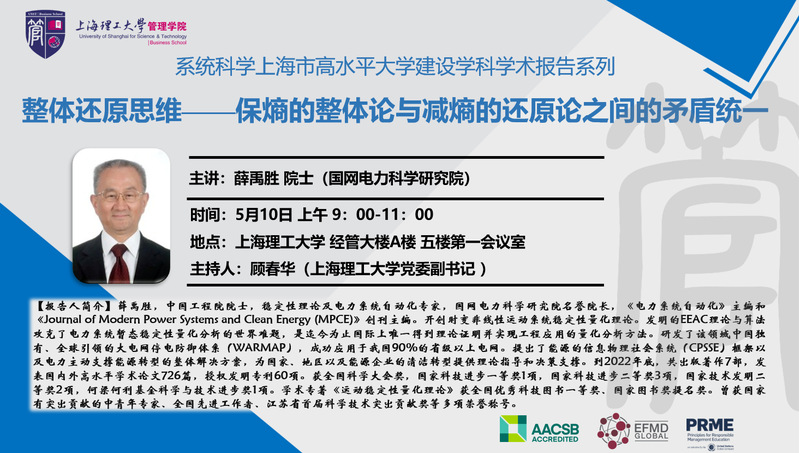
摘要:系统科学指出,复杂性研究需要整体论及还原论的协同。但尚未找到具体的途径,故目前仍限于思辨与理念。报告人近年提出的整体还原思维(WRT)兼容了整体论的全局观与还原论的机制观,可严格揭示复杂模型的动态行为机制。它将复杂性研究分为两个紧密融合的层次,即哲学层次上的方法论及领域层次上的定性分析。前者向后者提供方法论,而后者则根据具体的领域问题建立整体模型,给出其动态模式的定性分类,并在2维非线性哈密顿系统的相平面上提取量化指标。WRT的要点包括:通过多领域模型的混合仿真,将整体论要求的全部演化信息保存在轨迹中,从而克服了混杂模型带来的困难;按潜在的行为模式集,将整体的高维轨迹保熵映射为一系列正交的平面映像系统的相轨迹,从而克服了高维非线性的困难;通过时间分段技术,将各映像相轨迹所对应的方程分别表示为时变的2维线性方程,从而克服了处理强时变性及强非线性的困难。从整体模型出发,经过一系列“模型-空间-时间”上的Rn® nR2 保熵降阶映射,将高维轨迹(及模型)分别保熵映射为一系列两维的轨迹(及模型),以实现复杂系统动态行为的整体还原。在数学上严格证明了:在每次映射过程中,整体信息被严格转换到其映像系统的集合内。又由于每个映像系统只需要承载一个局部系统(不同领域间的交互,或模式空间,或时间段)的相关信息,故向单个映像平面的降阶映射则是个减熵的过程。换句话说,这一系列映射都是在整体保熵的前提下,让每个映像系统的不确定性不断减少的过程。这样,从模型、空间、时间的视角不断地“分解”,直到映像系统成为 2维“时空马赛克”的可还原单元系统,其局部的机制就可被揭示。由于这些线性映射矩阵都是可逆的,随后的逆映射过程就将局部机制聚合为整体系统的机制。其中的每次映射都分别突破一个技术壁垒,并不断削减需要还原处理的计算量。本报告介绍了WRT如何将长期对立的整体论与还原论融合为整体还原论,将线性的局部还原提升为非线性的整体还原,并思考了WRT目前的不足及发展的前景。
Holistic Reduction Thinking—— Synergism of the holistic theory of preserving entropy andthe reductionism of reducing entropy
Systems science points out that complexity research requires the synergy ofholism and reductionism. However, no concrete way has been found, so it isstill limited to speculation and ideas. In recent years, the reporter's holistic reduction thinking (WRT)combines the holistic view of holism and the mechanism view of reductionism andcan rigorously reveal complex models’ dynamic behavior mechanism. It dividesthe study of complexity into two closely integrated levels, namelymethodological at the philosophical level and qualitative analysis at thedomain level. The former provides methodology to the latter, while the latterestablishes an overall model according to specific domain problems, gives aqualitative classification of its dynamic mode, and extracts quantitativeindicators on the phase plane of a 2D nonlinear Hamiltonian system. The mainpoints of WRT include: through the hybrid simulation of multi-domain models,all the evolutionary information required by holism is saved in the trajectory,thereby overcoming the difficulties caused by heterogeneous models; Accordingto the set of potential behavior patterns, the overall high-dimensionaltrajectory entropy preservation is mapped to the phase trajectories of a seriesof orthogonal planar image systems, thereby overcoming the difficulty ofhigh-dimensional nonlinearity. Through the time-sectional technique, theequations corresponding to the trajectories of each image phase are representedas time-varying two-dimensional linear equations, which overcomes thedifficulties of dealing with strong time-varying and strong nonlinearity. Starting from the overall model, through a seriesof model-space-time Rn® nR2 entropy-preservingreduced-order mapping), the high-dimensional trajectory (and model) is mappedinto a series of two-dimensional trajectories (and models) respectively toachieve the overall restoration of the dynamic behavior of complex systems. Itis mathematically rigorously demonstrated that during each mapping process, theoverall information is strictly transformed into a set of its imaging systems.And since each image system onlyneeds to carry information about a local system (interaction between differentdomains, or mode space, or time section), the lower-order mapping to a singleimage plane is an entropy reduction process. In other words, this series ofmappings is a process that continuously reduces the uncertainty of each imagesystem under the premise of overall entropy preservation. In this way, from theperspective of model, space, and time, it is continuouslydecomposed until the image system becomes a reducible unit systemof 2-dimensional space-time mosaic, and its local mechanism can berevealed. Since these linear mapping matrices are reversible, the subsequentinverse mapping process aggregates the local mechanisms into the mechanisms ofthe overall system. Each of these mappings breaks through a technical barrierand continuously reduces the amount of computation that needs to be restored.This report introduces how WRT integrates long-term antagonistic holism andreductionism into integral reductionism, promotes linear partial reduction tononlinear whole, and considers the current shortcomings and prospects of WRT.
薛院士简介
薛禹胜,中国工程院院士,稳定性理论及电力系统自动化专家,国网电力科学研究院名誉院长,《电力系统自动化》主编和《Journal of Modern Power Systems and Clean Energy(MPCE)》创刊主编。
开创时变非线性运动系统稳定性量化理论。发明的EEAC理论与算法攻克了电力系统暂态稳定性量化分析的世界难题,是迄今为止国际上唯一得到理论证明并实现工程应用的量化分析方法。研发了该领域中国独有、全球引领的大电网停电防御体系(WARMAP),成功应用于我国90%的省级以上电网。提出了能源的信息物理社会系统(CPSSE)框架以及电力主动支撑能源转型的整体解决方案,为国家、地区以及能源企业的清洁转型提供理论指导和决策支撑。
到2022年底,共出版著作7部,发表国内外高水平学术论文726篇,授权发明专利60项。获全国科学大会奖,国家科技进步一等奖1项,国家科技进步二等奖3项,国家技术发明二等奖2项,何梁何利基金科学与技术进步奖1项。学术专著《运动稳定性量化理论》获全国优秀科技图书一等奖、国家图书奖提名奖。曾获国家有突出贡献的中青年专家、全国先进工作者、江苏省首届科学技术突出贡献奖等多项荣誉称号。




